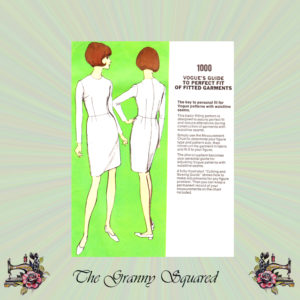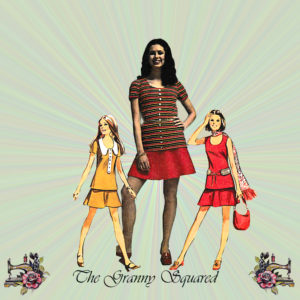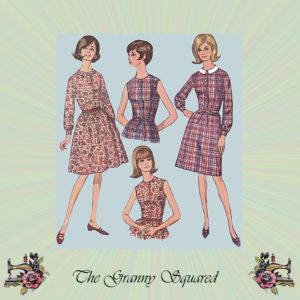There is a learning curve to using vintage sewing patterns. Patterns printed prior to 1980 assumed you had basic sewing skills. Knowing where to start is important. There can be a huge learning curve, especially for beginners. So why start with patterns from the 1960s and 1970s? They are readily available in a wide selection of sizes. You can go Mod or Boho if it suits you. Sticking with basic A-Line skirts and a basic top or blouse is another good choice. As long as your sewing machine can do a simple straight stitch, you should be able to sew any of the patterns listed below. If your machine has a zig-zag stitch and a zipper foot or button hole attachment, that will make things even easier.

Vogue has basic patterns that are perfect for the beginning sewist. If you want to sew a dress, try Vogue 1000, a dress shell that teaches you how to fit and sew a dress that has a waistline seam. This is not a dress that will be worn out in public. With a dress shell pattern, you typically start with muslin or other inexpensive fabric. Many vintage sewists purchase old bed sheet or tablecloths at a thrift store to make the shell. Another option is to get a gingham check fabric. The check pattern makes a fantastic grid which can help you make a precisely fitted dress. After you get a dress shell that fits you correctly, you will use this as a base for all other dresses. You will know where to put the darts, where to take in at the waistline, and how to fit the dress across your shoulders, bust, waist, and hips. This dress shell features long, set-in sleeves and a jewel neckline. You will need to sew in a zipper and add hooks and eyes to the shell. But that is what a shell is for – learning to get it all right and fitting it perfectly. Once completed, this will be your go-to pattern for all other Vogue dresses. When shopping for vintage Vogue patterns, look for titles like E-Z Vogue or Very Easy Very Vogue.

Simplicity has a great series of patterns from the 60s and 70s called Learn to Sew. These patterns have a sewing lesson printed on the pattern tissue. This lesson pertains to the pattern. For example, if you are into the Mod look of the late 1960s and early 1970s, Simplicity 8960–a mini dress with a flared skirt is a great choice for a beginner. The pattern teaches you how to hem a flared skirt, which is very different than hemming pants or straight skirts and dresses. Flared skirts have a curved hemline, making them a little more difficult to get right. Other things you will need to know for this particular pattern is how to sew in a back zipper and how to sew an elastic casing for the skirt. The top has a rounded neckline and a choice of set in sleeves or it can be sleeveless. Once you sew this pattern successfully you will have a very good grasp of basic dress and skirt construction.

Another good choice for a beginner is Simplicity 6308, a simple but cute dress from the 1960s. The pattern has a number of variations which makes it a great starting pattern for the beginner sewist. It includes a lesson on how to set in a sleeve. This particular pattern can be made with long, set in sleeves or it can be sleeveless. The collar is another option. If you choose to add the collar, it can be made from a contrasting fabric or it can match the rest of the dress. If collars are not your thing, you can make the dress without it. A third option with this dress is the skirt. It can be a gathered skirt or A-line. The A-line skirt will be easier to hem. If you choose a gathered skirt, it is gathered at the waistline. You will also tackle a side zipper and a button front bodice.
What did you sew? Post your successes, failures, and thoughts in the comments. I’d love to hear from you.